Shopify vs Squarespace: Which is Best for Your Online Store?
Shopify and Squarespace are two of the most widely used ecommerce platforms, and it can be tough to figure out which one is the best fit for your business.
This article will take a detailed look at the features and distinctions of Shopify vs Squarespace to help you decide which platform is right for your specific needs.
| Key Takeaways |
|---|
|
Shopify vs Squarespace: Quick comparison
The difference between Shopify vs Squarespace lies in their core, their initial focus. Shopify is primarily focused on ecommerce and provides a comprehensive suite of features to support online selling. Squarespace, on the other hand, is more widely known as a website builder that offers ecommerce functionality.
However, as competitors to each other, both platforms are not too different in their ecommerce features and are still competing and progressing in delivering better experiences for the users.

Shopify has been known as an ecommerce-focused platform ever since it was released in 2006. Meanwhile, Squarespace started as a website builder before it expanded its services to include ecommerce functionality. Both today are trying their best to provide an all-in-one solution for online stores to thrive in the ecommerce competition.
Despite being a relatively late entrant in the ecommerce platform market, Squarespace has managed to establish itself as one of the most popular platforms with approximately 360k online stores. However, compared with Shopify, that number is absolutely dwarfed. The winner in the ecommerce race is Shopify, powering over 4.1 million businesses in about 175 countries.
Shopify vs Squarespace: Table Comparison
| Criteria | Shopify | Squarespace | Winner |
|---|---|---|---|
| Pricing | Basic plan starts at $39/month No transaction fees for using Shopify Payments 0.5–2% per transaction using third-party payment gateways |
Business plan starts at $33/month Transaction fees ranging from 0% to 3% of sales |
Depending on your business size and volume |
| Sales Features | Comprehensive sales features with some additional advanced features. | Comprehensive sales features | Shopify |
| Marketing Features | Comprehensive marketing features with some advanced analytics features and free email marketing tools. | Comprehensive marketing features with excellent blogging features. | Shopify |
| Ease of Use | Beginner-friendly platform with an intuitive interface and easy setup. Have a steeper learning curve | Beginner-friendly platform with an intuitive interface and easy setup. Easier and quicker to start. | Squarespace |
| Dropshipping | A wider range of dropshipping apps. | Few multiple third-party dropshipping extensions available. | Shopify |
| Tax calculations | More advanced tax rule options, third-party tax app options, and better integration with accounting software. | simple tax tools | Shopify |
| Apps and Extensions | Wide range of free and paid apps and extensions available in the Shopify App Store. | Limited selection of apps and extensions available in Squarespace Marketplace, with mostly paid options. | Shopify |
| Help and Support | 24/7 customer support via phone, email, and live chat. Extensive documentation and online forums available. | Customer support available via email and live chat, with limited hours. | Shopify |
| Security | Strong security features with SSL encryption, fraud analysis, and automatic backups. | Strong security features with SSL encryption and automatic backups. | Shopify |
| Themes and Templates | Wide range of free and paid themes available, with customization options. | Elegant templates but limited customization options. | Shopify |
Shopify is better than Squarespace because:
- Better sales features: Shopify is more focused on ecommerce, thus offering a wider range of sales features than Squarespace. For example, Shopify has more options for managing inventory, handling shipping, and creating product variations.
- More apps and extensions: Shopify offers a wider selection of third-party integrations and apps than Squarespace, making it easier to find specific features or integrations that your business needs.
Squarespace is better than Shopify because:
- More affordable: Squarespace is generally more affordable than Shopify, with lower monthly fees and no transaction fees.
- Better for design: Squarespace is known for its beautiful and customizable templates, making it a great choice for businesses that prioritize design.
- Better for content-heavy sites: Squarespace has more advanced blogging and content management features than Shopify, making it a better choice for businesses that produce a lot of content.
Shopify vs Squarespace: In-depth Comparison

Shopify vs Squarespace: Build Online Store
| Functions | Shopify | Squarespace |
|---|---|---|
| Ecommerce Features | More robust with features like integrated dropshipping, tax calculation, order management, inventory tools. | More basic ecommerce features. |
| Payment Options | Supports over 100 payment gateways. | Only supports PayPal and Stripe. |
| Templates | 12 free templates. Large selection of paid templates. | 155 free templates. Templates are generally better for content sites. |
| Importing/Exporting | More flexible product importing and exporting. No limits. | Limitations like 10,000 product export limits. |
| Mobile Performance | Generally faster loading site speeds based on tests. | Sites load slower than Shopify on mobile. |
| Apps | Over 8,000 apps extend store functionality. | Limited app ecosystem. |
| Better For | Building Sophisticated Online Stores. | Simple stores or content-focused sites. |
Shopify vs Squarespace: Support Offline Store
Shopify:

- Has a dedicated POS (point-of-sale) system that allows sellers to ring up customers in physical retail locations.
- The POS software syncs inventory and transactions instantly with the online Shopify store.
- Offline sales are reflected immediately in online order reports and inventory levels.
- POS works seamlessly across online and offline channels under one platform.
Squarespace:
- Does not have a native POS system for offline stores.
- Relies on a partnership with Square to enable physical point-of-sale capabilities.
- Requires using separate Square hardware and software at retail locations.
- Offline sale data syncs with online stores but may not be as seamless as Shopify integration.
- Sets offline as a separate channel rather than a fully integrated system.
Overall:
- Shopify provides a unified online/offline store experience through its POS app .
- Squarespace sellers must manage physical retail separately through Square.
- Shopify POS allows sellers to have inventory and customer data across all sales venues.
- Squarespace may be unable to link data between online and POS platforms.
Shopify offers robust native support for integrated offline/online stores through its comprehensive POS system. Squarespace partners with Square but does not provide the same level of unified system for both online and physical retail operations.
Shopify vs Squarespace: Build Content Website

| Functions | Shopify | Squarespace |
|---|---|---|
| Better for | Ecommerce, online stores | Content-driven websites, blogs |
| Templates | 12 free templates, paid template store | 155 free templates |
| Content Management | Improved but not as flexible as Squarespace | Easy drag-and-drop editing, block layouts |
| Commerce Features | More extensive selling tools, features, integrations | Fewer dedicated store templates and tools |
| Payments | Accepts globally, many gateways | Two gateway options |
| Point of Sale | Wide range of POS hardware, robust Pro add-on | Limited to Square readers in the US |
| Customization | Less flexible, "closed system" | Templates highly customizable |
| Strengths | Powerful ecommerce, apps, scalability | Easy creation, flexible content display |
Pricing
Subscription fees
Shopify Subscription fees
Shopify offers 5 pricing plans:
- Shopify Starter Plan - This plan costs $5 per month and allows users to add a Buy button and sell on social media.
- Basic Shopify Plan - This plan costs $39 per month and includes features such as unlimited products, 24/7 support, and access to sales channels like Facebook and Instagram.
- Shopify Plan - The Shopify plan costs $105 per month and includes all features of Basic Shopify, plus standard reports and ecommerce automation.
- Advanced Shopify Plan - This plan costs $399 per month and includes all ecommerce features of the Shopify plan, plus advanced reports, third-party calculated shipping rates, and duties and import taxes.
- Shopify Plus - This is a custom plan designed for high-volume merchants and includes all the features of Advanced Shopify, plus unlimited staff accounts, advanced security, and priority support.
For annual plans on Shopify, you can save 25% of the upfront fees:
- Basic Plan: $29 per month
- Shopify Plan: $79 per month
- Advanced Shopify Plan: $299 per month
You can start a 3-day free trial to use Shopify for free. During the trial period, you will have access to all the features included in any of the Shopify plans and decide if it is the best fit before committing to a plan.
Squarespace Subscription fees
Squarespace offers 4 pricing plans for e-commerce:

- Personal - This plan costs $23 per month, allowing you to create a website but not sell anything.
- Business - The Business plan costs $33 per month and includes all features of the Personal plan, plus website analytics, unlimited products, and third-party services.
- Commerce Basic - This plan costs $36 per month and includes all features of the Business plan, plus product reviews and a custom checkout page.
- Commerce Advanced - This plan costs $65 per month and includes all features of the Basic Commerce plan, plus abandoned cart recovery and advanced shipping and discounts.
With Shopify, you can start selling on any plan, even with the $5 Starter Plan. But with the cheapest plan on Squarespace, you can’t sell anything.
For annual plans on Squarespace, you can save 24%–30% of the upfront fee:
- Personal - $16 per month
- Business - $23 per month
- Commerce Basic - $27 per month
- Commerce Advanced - $49 per month
You can use Squarespace for free for 14 days to test out this platform before committing to a subscription plan.
Transaction fees and credit card rates
| Shopify | Squarespace | |
|---|---|---|
| Transaction Fees (if using platform's payment system) | None for Shopify Payments | 3% on all sales for Business plan |
| Transaction Fees (if using 3rd party processor) | 2% for Basic, 1% for Shopify, 0.5% for Advanced | N/A (only offers own system) |
| Credit Card Rates Online | 2.9% + $0.30 for Basic, lower on other plans | 2.6% + $0.30 for all Visa/MC |
| Credit Card Rates In-Person | 2.7% + $0 for Basic, lower on other plans | 2.6% + $0.30 for all debit/credit cards |
| Payment Methods Accepted | Multiple including Amex | Visa and Mastercard only |
| Fees Compared to Features | Potentially lower fees on Shopify if offset by extra features | Uniform fees regardless of plan/features |
Sales Features
Payment options
Payment gateways
A wide range of payment gateways makes it easy for businesses to accept online payments and reach a wider customer base. This provides flexibility and convenience for customers, increasing the chances of completing a sale for the merchant. Thus, online sellers definitely need to consider whether a platform offers a wide range of payment gateways.
Both Shopify and Squarespace offer payment gateways. However, there is a huge gap regarding the number of payment gateways each platform offers.
When it comes to payment gateways, Shopify offers a wider range of choices, with over 100 payment options available, including popular providers like PayPal, Stripe, and Apple Pay, as well as its own payment gateway—Shopify Payments. This can give customers more payment options, which may lead to increased satisfaction and loyalty.
However, Squarespace has a more limited selection of payment options, including Stripe, PayPal, Apple Pay, and Afterpay. It’s important to check the availability of payment gateways in your region, as some options may not be available. For example, Afterpay on Squarespace is only available in select regions. This could limit payment options for customers and potentially result in lost sales.
Selling in different currencies
You can sell internationally on both Shopify and Squarespace. However, Shopify has a more extensive list of supported countries and currencies than Squarespace. Shopify even automatically detects the customer’s location to display prices in their local currency.

Meanwhile, Squarespace supports various countries and currencies; however, the number is smaller compared to Shopify.
As the biggest ecommerce platform at present, Shopify definitely wins due to a more extensive range of payment gateway options and more supported currencies.
Shipping options
Of course, shipping is a crucial part of running an online store. But which has better shipping options: Shopify vs Squarespace?
In fact, Shopify and Squarespace offer pretty similar shipping features to their users:
- Seamless integration with major shipping carriers such as USPS, FedEx, and UPS.
- Flexible shipping rate calculation options: flat shipping rates, real-time shipping rates based on weight, price, and destination, free shipping rates, and local pickup rates.
- Shipping discounts and promotions.
- International shipping.
However, Shopify has a slight edge over Squarespace as it offers seamless integration with more carriers. Shopify also has more advanced shipping features, such as custom shipping rates. With this feature, merchants can set custom quotes for different groups of packages (heavier packages or lighter packages) instead of just setting one flat rate for all. This reduces the time to edit the rate for each product and also saves you some money.
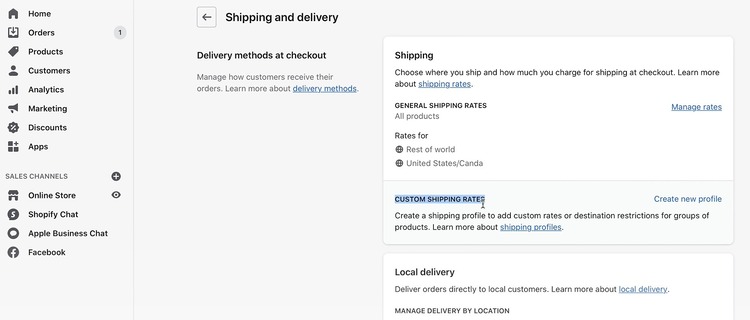
Shopify’s shipping settings
And I personally like the shipping settings interface on Shopify more than Squarespace, as it looks more comprehensive and intuitive. Squarespace’s shipping setting interface is rather simplified and too basic.
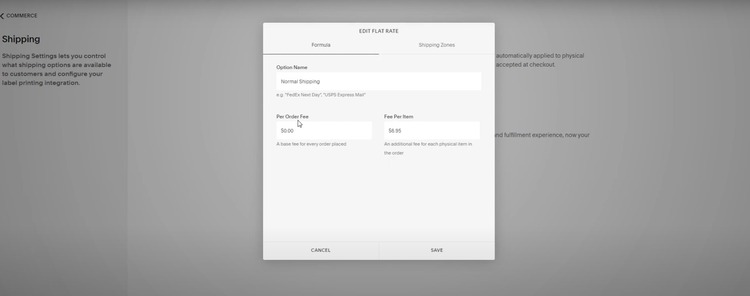
Squarespace’s shipping settings
Inventory Management
Inventory management is a crucial part of running an online store. It helps merchants keep track of their products, avoid losses from overstocking or stockouts, and maintain accurate product listings for customers.
Both Shopify and Squarespace have robust inventory management. They allow you to track inventory levels and receive notifications when stock is low or out of stock. You can also manage and track inventory for multiple locations and warehouses. Plus, you can use advanced features such as built-in barcode scanning on both platforms.
However, there are also some differences between Shopify vs Squarespace regarding this aspect:
- Shopify has a backorder feature, which allows customers to purchase products that are currently out of stock. However, Squarespace does not currently have this feature available.
- Shopify offers a user-friendly interface and advanced capabilities for managing your inventory and products. This includes organizing and editing your product listings to ensure accuracy and efficiency. Squarespace’s stock management system is more basic than Shopify’s, with fewer features for tracking and managing your inventory.
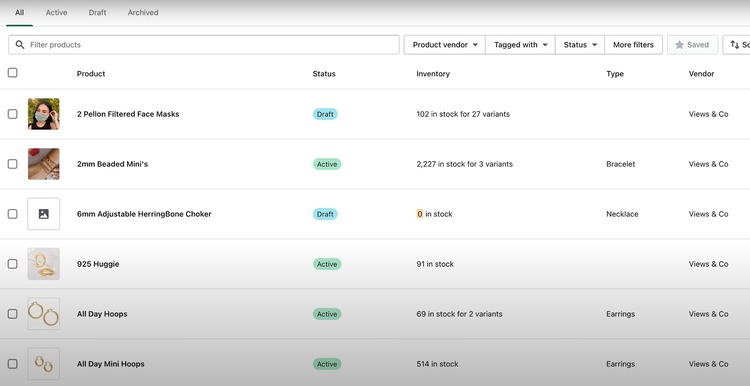
Shopify’s stock management system
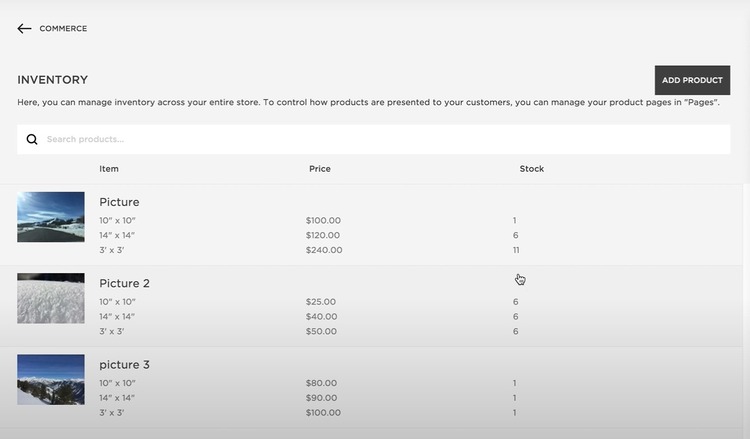
Squarespace’s inventory management system
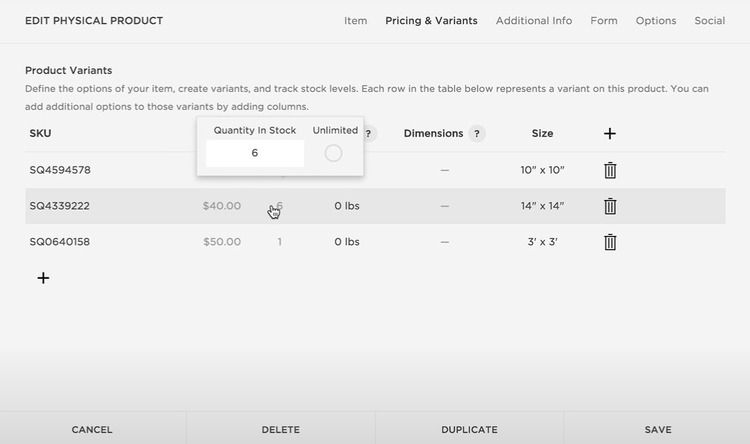
Squarespace’s inventory management system
Product types
Do Shopify and Square differ much in terms of product types?
Unlikely.
In fact, you can sell a wide range of products on Shopify and Squarespace, including:
- Physical Products, such as clothing, accessories, beauty products, home goods, and electronics.
- Digital Products, such as eBooks, music, videos, software, online courses, and memberships.
- Services, such as consultations, appointments, and workshops.
- Subscriptions, including products that customers can sign up for and pay for on a recurring basis.
- On-demand Products, including customizable products that allow customers to personalize their purchases. This can include adding custom text, choosing colors, or selecting specific product options.
The difference is the way that each platform handles digital products. Squarespace has a file size limit of only 300MB for digital products, while Shopify allows up to 5GB.
Overall, both platforms offer a range of options for selling physical and digital products, but Shopify may be a better fit for businesses with larger product catalogs or more complex product management needs.
Product options and variants
Product options are what type of products, while product variants are the exact model of products. Color and shape are product options. But a square red notebook is a variant.
An online store that offers more choices of product variants could result in more purchases, and you should consider this aspect when choosing an ecommerce platform.
Both Shopify and Squarespace provide the option to create product variants, including size, color, material, and other attributes. This feature helps to expand the range of choices available to customers when they make a purchase.
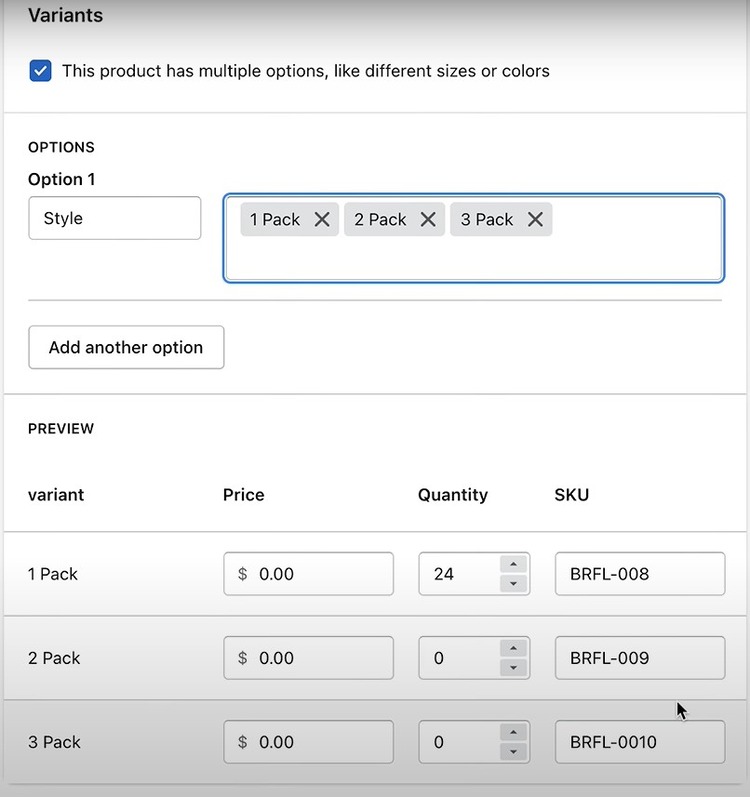
Shopify’s product variants settings
For now, Shopify allows merchants to add up to 3 product options and 100 variants. Meanwhile, Squarespace lets you add up to 6 product options and 250 variants. If your business offers a wider range of product options, Squarespace may be a better choice. However, it’s worth noting that Shopify still offers support for infinite variants through the use of third-party apps, so it’s not necessarily a deal-breaker for larger businesses.
Point of sale (POS)
Both Shopify and Squarespace provide a point of sale (POS) system that enables merchants to sell their products in person at various events, markets, and pop-up shops. Both Shopify and Squarespace offer cloud-based point-of-sale systems, giving users the ability to access their sales data and manage their inventory from any device with an internet connection.
With their POS systems, you can:
- Scan barcode scanning and print receipt.
- Manage orders, issue refunds, and send email receipts.
- Have flexible payment options and integration with major payment gateways.
The only thing is Shopify POS system supports a wider range of hardware, including barcode scanners, cash drawers, receipt printers, and card readers.
In terms of card readers, Shopify POS provides multiple options, including their own Shopify Tap & Chip Reader and the popular Square Reader. These card readers are compatible with a variety of devices, including smartphones, tablets, and computers.
Unlike Shopify, Squarespace offers fewer hardware options but still supports a range of devices, such as barcode scanners, receipt printers, and cash drawers. Squarespace also offers its own Squarespace Point of Sale app for iOS and Android devices, which allows users to accept payments, manage inventory, and more. You will need the Squarespace Commerce app and a Square card reader. Also, note that Squarespace POS is only available with a Commerce Basic or Commerce Advanced plan.
But it’s worth noting that the Squarespace POS system is included in their Commerce Basic and Commerce Advanced plans, whereas the Shopify POS system is available in all plans.
Abandoned cart recovery
Both platforms offer abandoned cart recovery features that allow users to send automated emails to customers who have left items in their shopping cart without completing the purchase. You can send multiple emails with personalized product recommendations, discount codes, and other incentives to encourage customers to complete their purchases.
One advantage of Shopify’s abandoned cart recovery feature is its ability to provide detailed analytics on cart abandonment rates and recovery rates. This allows businesses to track the success of their recovery efforts and make adjustments to their messaging and discount strategies as needed.
Meanwhile, only when you use Squarespace’s Advanced Commerce can you use this feature. Though both have the abandoned cart recovery feature, Shopify offers more advanced functionalities to make the most of this feature. However, they are available only on its higher-tier plans.
The verdict:
Shopify is the clear winner in terms of sales features with slightly more advanced sales features.
Marketing Features
SEO (Search Engine Optimization)
Both Shopify and Squarespace provide users with built-in SEO features that can help optimize their websites for better visibility on search engines.
- URL structure: Both platforms automatically generate a clean and SEO-friendly URL structure but also let you customize URLs manually.
- Meta tags: Both platforms allow you to customize meta tags, including title tags and meta descriptions.
- SSL Certificates: Both platforms ensure secure transactions and protect customer data.
- Mobile optimization: Both platforms offer mobile-optimized websites, but Shopify’s mobile optimization is more customizable and flexible. Additionally, Shopify has a dedicated mobile app for managing your online store on the go.
- XML sitemaps: Both platforms offer automatic generation of XML sitemaps to make it easier for search engines to crawl and index the site.
However, we analyze and see that Shopify is better than Squarespace in terms of SEO features. Here are the reasons why:
- Page speed: We know that page speed is crucial for SEO. Both platforms offer fast-loading websites. However, as a study indicates, Shopify is slightly faster than Squarespace, with an average loading time of 1.3 seconds compared to Squarespace’s 3.5 seconds.
- Analytics: Both platforms offer built-in analytics tools to track website traffic and performance. However, Shopify’s analytics dashboard is more comprehensive and user-friendly.
- Integrations: Shopify has a vast app store with a large app market, including popular SEO tools like Yoast and SEMrush. Squarespace, on the other hand, has very few extensions and a handful of marketing tools.
Email Marketing
Both platforms offer built-in email marketing capabilities. In Shopify, this feature is a free app called “Shopify Email,” while the Squarespace Email Campaigns tool costs you from $7 to $68 per month. Both apps allow users to:
- Use a library of customizable email templates.
- Design and customize your email campaigns with your own branding and imagery. You can insert product images and blog posts directly into emails. Even non-designers can create professional-looking emails.
- Manage your email lists and segment their subscribers based on customer behavior and purchase history to create custom emails.
- Set up automated email campaigns, such as welcome series or abandoned cart reminders.
- Offer basic reporting and analytics on email campaign performance, including open rates, click-through rates, conversion rates, tracking revenue generated from email campaigns and comparing the performance of different campaigns. With Shopify Email, you can use all email marketing features. However, because it’s a free version, Shopify only lets you send up to 10,000 emails for free. Meanwhile, Squarespace limits several aspects depending on the package you use as below:
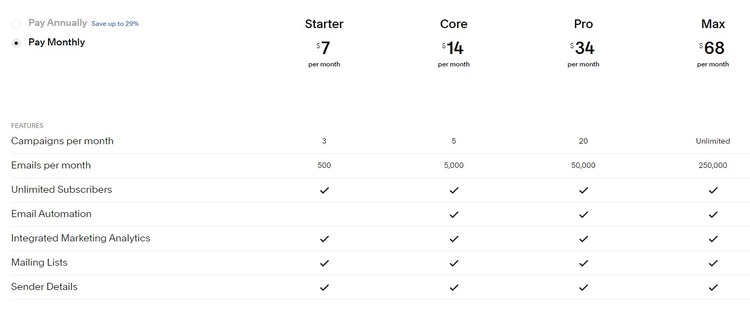
Overall, while both Shopify and Squarespace offer email marketing capabilities, Shopify, with its free offering and no lesser features than Squarespace, is considered a better option.
Social Media Integration
When it comes to Social Media Integration, both Shopify and Squarespace offer a range of features that enable users to integrate their online store with various social media platforms.
- Sell products directly on Facebook and Instagram.
- Use the Facebook ads feature.
Squarespace offers the additional advantage of integrating with the Unsplash stock photo library, which provides access to a vast collection of high-quality images that can be used on social media. However, this feature is not available on Shopify.
However, Shopify has another advantage over Squarespace as it integrates with more social channels, including Pinterest and Twitter.
Discounts and Coupons
Both Shopify and Squarespace provide their users with the ability to create discount codes and coupons to offer promotions to their customers. However, Shopify offers more flexibility, allowing users to create discount codes based on specific product or collection conditions. This means that Shopify users can offer discounts on specific items or collections, which can be useful for running targeted promotions.
Product Reviews
Both platforms allow merchants to show product reviews on their online store. This is a built-in feature on Squarespace, and you can import Etsy reviews on Squarespace. You can set up email notifications sent to buyers to request a product review.
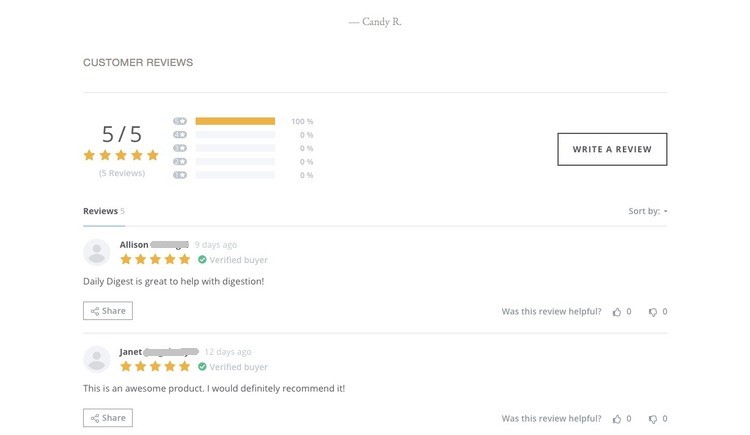
Shopify does offer a similar or even better-looking product review feature. However, you’ll have to install an app to use it on Shopify.
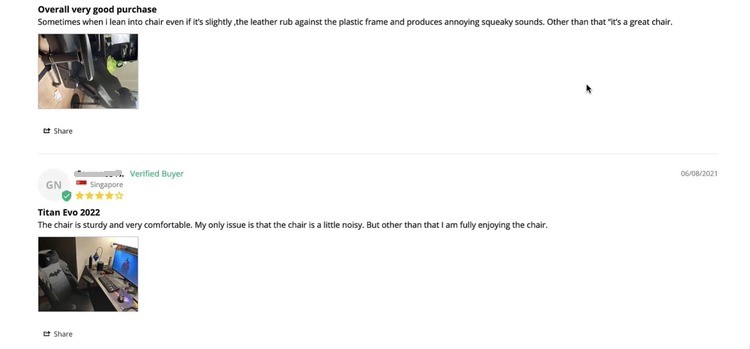
Blogging functionality
Both Shopify and Squarespace offer built-in blogging features that enable users to create and publish blog posts on their websites.
Both Shopify and Squarespace offer:
- Both Shopify and Squarespace offer built-in blogging features.
- Users can create and publish blog posts directly on their ecommerce sites.
- Basic text editing tools and image and video embedding options are available.
- Users can organize posts into categories and tags for easy navigation.
- Users can customize their blog’s design, format, and layout.
Both Squarespace and Shopify offer blogging features with similar functions, but Squarespace’s blogging tools are known for being more customizable and flexible. Squarespace provides a wider range of design options, and users can add custom fields to their blog posts. In fact, Squarespace’s blogging features look similar to those found on WordPress, which is the most popular blogging platform. On the other hand, Shopify’s blogging features are more basic and resemble the classic editor found on WordPress.
Overall, while both Squarespace and Shopify offer blogging features, Squarespace may be a better option for users who prioritize design customization.
Reporting and Analytics
The reporting and analytics features available on Shopify and Squarespace are similar in terms of functionality, allowing users to generate reports on website traffic, sales performance, and customer behavior and track key performance metrics like conversion rates and average order value. You can access reporting features right in the Shopify dashboard and Squarespace dashboard.
However, Shopify’s reporting and analytics features are known to be more advanced and powerful.
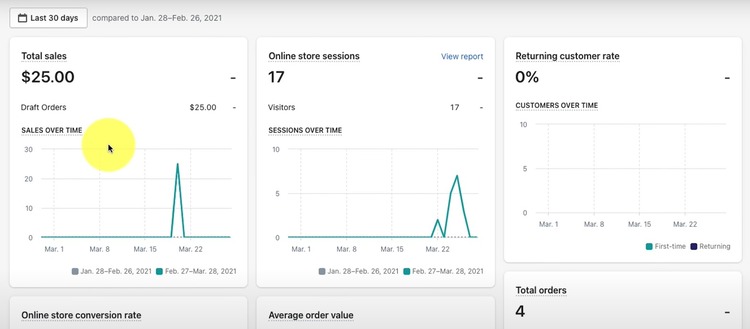
Shopify’s analytics dashboard
Additionally, both platforms offer integration with Google Analytics, enabling users to gain even more insights into their online store’s traffic and user behavior.
However, there are some differences between the reporting and analytics features of Shopify and Squarespace.
Shopify provides advanced reporting features that enable users to track and compare sales across various sales channels, analyze customer lifetime value, and generate custom reports. These features are readily available in the Shopify dashboard and are especially beneficial for larger ecommerce businesses that require in-depth analysis of their sales data. However, the most powerful analytics tools are only accessible on mid-tier and high-tier plans for both Shopify and Squarespace, meaning users must pay more to access them.
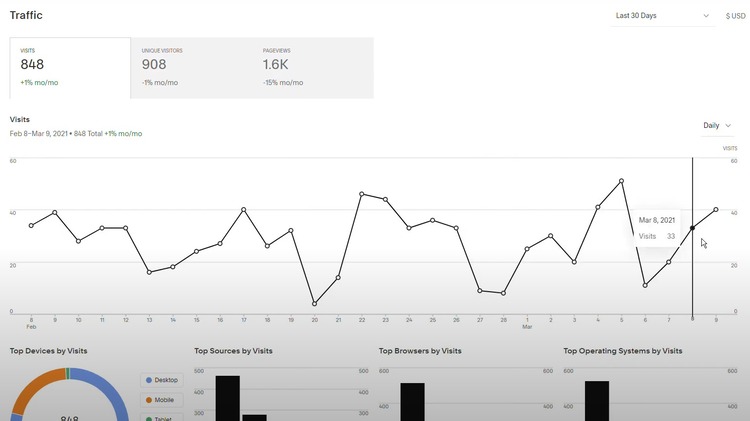
Squarespace’s analytics dashboard
In contrast, Squarespace’s reporting and analytics features are more simplified and user-friendly, which is beneficial for small businesses or users who may not have technical expertise. These features are designed to be more accessible and easier to comprehend, enabling users to understand their data and make informed decisions.
The verdict:
Shopify wins this battle as it has a wider range of marketing tools and analytics and good SEO and blogging features.
Ease of Use
Both Shopify and Squarespace provide drag-and-drop interfaces that are easy for beginners to use and enable them to set up an online store quickly. They also offer a variety of pre-built templates and themes that are elegant, customizable, and optimized for mobile devices.
Squarespace’s Fluid Engine enhances usability and design capabilities, enabling users to edit and preview changes in real time. At the same time, the drag-and-drop interface allows for easy rearrangement of content and the addition of new elements to the website.
Setting up an online store on these platforms is so straightforward that it can take as little as an hour.
The verdict:
Squarespace wins as it is easier to use. Compared to Squarespace, Shopify has a steeper learning curve.
Dropshipping
As the need for dropshipping business gets increasingly popular, most popular ecommerce platforms, including Shopify and Squarespace, now support dropshipping. Shopify has been providing the dropshipping business model since 2015, while Squarespace only recently introduced it in 2021.
Both platforms provide the fundamental features to dropship products, such as:
- Easy product management, including the ability to add product descriptions, images, and prices.
- A wide range of payment gateways, including popular options like PayPal and Stripe.
- Features to manage shipping rates, tracking, and delivery notifications.
- Integration with popular dropshipping apps and seamless import of products from various suppliers.
So, both Shopify and Squarespace allow for easy setup of a dropshipping business with just a few clicks. However, Shopify may be a better choice as it offers a wider range of dropshipping apps compared to Squarespace.
The verdict:
Shopify is the better option for dropshipping as it has more dropshipping apps.
Tax calculations
Squarespace and Shopify offer built-in tax calculation tools that make it easy for online store owners to manage and calculate taxes. Here are some similarities and differences between the tax calculation tools offered by both platforms:
- Both Shopify and Squarespace have automatic tax calculation features that determine the tax rate for each order based on the customer’s location.
- Both platforms offer tax exemptions for specific products or customers, like non-profit or wholesale customers.
- Both platforms support multiple currencies to facilitate international selling.
Both Shopify and Squarespace offer built-in tax calculation tools that can help online store owners manage taxes. However, Shopify has more third-party tax app options and better integration with accounting software.
- Shopify provides better integration with accounting software and has more third-party tax app options than Squarespace.
- Shopify has a wider range of third-party tax apps available in their app store, which is helpful for businesses with complex tax needs.
- Shopify offers detailed tax reports that can be exported for accounting purposes, whereas Squarespace’s tax reporting lacks the same level of detail.
The verdict:
Shopify wins as it allows users to access more advanced tax and accounting tools.
Apps and Extensions
Both Squarespace and Shopify provide options for sellers to expand their online store’s capabilities through third-party apps and extensions. However, Shopify’s app store has a larger selection of add-ons compared to Squarespace’s store.
Shopify has over 8,000 apps available, while Squarespace has just 31 extensions. This means that Shopify users have access to more choices of tools and features to improve their ecommerce performance. As the competition is fierce, app developers hence have to do their best to deliver competitive and satisfactory products.
The app market was first released in 2019, and ever since, the number of apps remains—still 31 extensions. The apps available can be categorized into four main categories: Shipping and Fulfillment, Finance, Inventory and Products, and Sales and Marketing. Note that some apps may be limited to certain regions or countries.

Shopify App Store
Though Squarespace offers fewer options, the ones available on the Squarespace store are must-haves for any ecommerce store. And I think that the fewer choices of extensions in Squarespace could be an advantage as it reduces the time to choose an extension. In case the app you need is not there yet, you can still use an intermediary integration like Zapier to connect your Squarespace store with other apps and extensions.
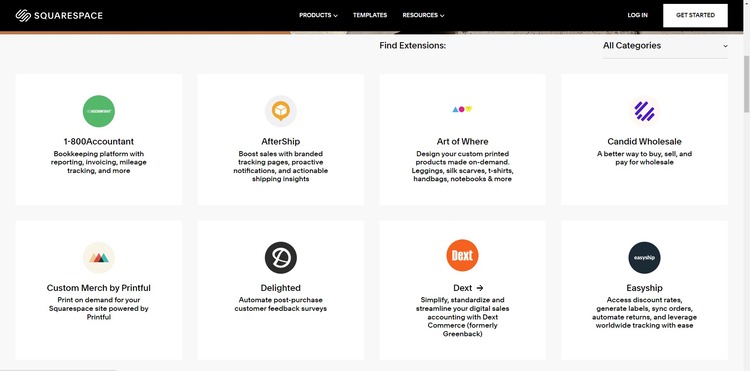
Squarespace App Store
The verdict:
Shopify has the advantage of a wider range of options available. This means that Shopify is more customizable and can better meet the unique needs of different businesses.
Help and Support
Both Shopify and Squarespace provide a variety of help and support options to assist users with their ecommerce stores. They both have a knowledge base with articles and tutorials covering a wide range of topics related to ecommerce, as well as community forums where users can ask questions and get help from other sellers and experts. However, since Shopify has a larger customer base, there are more reviews and tutorials available for it compared to Squarespace.
Shopify also takes it a step further by providing 24/7 support through all channels, including email, live chat, phone, and social media. This means that if you have a question or concern, you can expect a quick response within 5 minutes.
Meanwhile, customer support in Squarespace is more limited than in Shopify. 24/7 support is only available via email, Twitter, and Facebook. Meanwhile, there are some time restrictions if you contact via live chat and no phone support.
It’s worth noting that Shopify offers support in multiple languages, such as English, French, German, Spanish, Italian, Portuguese, Dutch, and Japanese, whereas Squarespace only provides support in English.
The verdict:
Shopify has a stronger customer support offering with round-the-clock availability for phone and chat support.
Security
Squarespace and Shopify offer similar security features:
- SSL Encryption: Both platforms offer SSL encryption for secure data transfer between the website and the user’s browser. SSL encryption ensures that all data, including personal and financial information, is encrypted and secure.
- Payment Gateways: Both Shopify and Squarespace provide integration with trusted payment gateways such as PayPal, Stripe, and Apple Pay. These gateways are certified to comply with industry standards such as PCI-DSS, ensuring secure payments.
- Two-Factor Authentication: Both platforms offer two-factor authentication for admin accounts, which adds an additional layer of security.
- Security Updates: Both platforms release regular security updates to fix vulnerabilities and keep the platform secure.
- Hosting: Squarespace and Shopify have cloud hosting designed for high traffic and offer better security, scalability, and reliability.
However, there are several differences between Shopify vs Squarespace:
- PCI Compliance: Shopify is fully PCI compliant, meaning it meets all the security requirements of the Payment Card Industry Data Security Standard. Squarespace, on the other hand, is only partially PCI compliant, meaning it meets some but not all requirements.
- Fraud Prevention: Shopify offers built-in fraud prevention tools that use machine learning to detect and prevent fraud. Squarespace, on the other hand, relies on third-party fraud detection services.
The verdict:
Shopify is better than Squarespace in terms of security features. Shopify applies slightly more advanced security technology and in-house fraud protection tools.
Themes and Templates
Both platforms offer a wide range of professionally designed themes and templates that users can customize to fit their branding needs. Shopify has 122 themes in its theme store, while Squarespace offers over 150 templates. However, while Shopify themes are curated only for ecommerce stores, those on Squarespace are for various purposes, such as blogging.
It’s worth noting that there are only a handful of ecommerce templates on Squarespace. However, the number of themes and templates doesn’t matter much since you can absolutely resort to third-party theme providers to get you the most suitable themes.
One significant difference between Shopify vs Squarespace is the level of customization allowed. If you are a professional website designer, you may find both platforms quite limited in terms of customization. As fully hosted platforms, they both don’t allow you to fully customize your site. And if you want to access advanced customization, you need to have some coding knowledge.
But out of the two platforms, you would still find Shopify better for customization. Squarespace, with its limited themes and customization, somehow makes your site less unique—just like a professional web designer reviewed: it’s so easy to recognize Squarespace sites as they look pretty similar.
Switching templates
Switching templates is easy on both platforms. Shopify allows users to switch between any of the available themes or templates. At the same time, Squarespace offers a similar feature called “Template Switching,” allowing users to change their website’s template while maintaining their content.
Importing and exporting content
Squarespace and Shopify offer the ability to import and export content. Shopify allows users to import and export their products, customers, orders, and other data. Squarespace, on the other hand, allows users to import and export content such as blog posts, pages, and galleries, but you can’t import a customer database.
Editing HTML and CSS in Shopify and Squarespace
Shopify allows users to edit the code directly, giving users more control over their site’s appearance. Shopify users can edit their HTML, CSS, and JavaScript files directly in the platform or use a code editor of their choice. Squarespace, on the other hand, does not allow users to edit their template’s HTML and CSS directly. However, Squarespace offers a Code Injection feature that allows users to add custom code to their site’s header or footer.
Shopify and Squarespace offer a variety of themes and templates that users can customize to fit their branding needs. Switching templates and importing/exporting content are also easy on both platforms. However, Shopify has more customization options, allowing users to edit the code directly, while Squarespace restricts users from editing their template’s HTML and CSS directly.
The verdict:
Shopify comes out on top in terms of flexibility and customizability, allowing users to create more diverse and adaptable themes. On the other hand, Squarespace offers visually stunning templates that even those with little design experience can use to create beautiful and elegant websites.
Overall Winner
After examining the various criteria in the comparison table, it’s clear that Shopify is the overall winner between the two ecommerce platforms.
In terms of pricing, Shopify is more expensive than Squarespace and has higher transaction fees.
When it comes to sales and marketing features, customization options, and apps, Shopify has the upper hand. However, Squarespace has a simpler and more user-friendly interface.
Shopify also offers advantages in dropshipping, tax calculations, app store options, and customer support. It has a better reputation in the industry and is trusted by more businesses.
While Squarespace has its strengths, Shopify’s overall package of features, ease of use, support, and market share makes it the clear winner for most businesses looking to launch and grow an ecommerce store.
Shopify vs Squarespace: FAQs
The answer to the question of whether to use Shopify or Squarespace ultimately depends on your business’s specific needs and goals. Both platforms have their own unique strengths and limitations, so it’s important to consider them carefully before making a decision.
Shopify is an excellent choice for businesses that prioritize selling products online. It offers a wide range of ecommerce-specific features, including payment processing, shipping and fulfillment tools, and customizable storefronts. Shopify is also highly scalable and can support businesses of all sizes, making it a great choice for businesses with big growth ambitions.
On the other hand, Squarespace is a good fit for businesses that want a website builder with integrated ecommerce functionality. It offers intuitive website design tools and a range of ecommerce features, including payment processing and inventory management. Squarespace is especially suitable for businesses that want to build a strong online presence with high-quality design and aesthetics.
Who should use Shopify? And who should use Squarespace?
Shopify is best for:
- Online retailers, small businesses, solo entrepreneurs and entrepreneurs looking for a comprehensive ecommerce solution
- Businesses that have a large inventory and need advanced inventory management tools
Squarespace is best for:
- Creatives, artists, photographers, and designers who want a visually stunning website
- Small businesses that want a simple, easy-to-use website builder
Shopify vs Squarespace: Conclusion
Squarespace and Shopify are both powerful ecommerce platforms that come with their own set of unique benefits. By understanding the differences between the two, you can make an informed decision on which one is best suited for your business. Before committing to either platform, it’s crucial to research and compare them to ensure you’re making the right choice.





